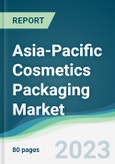The Asia-Pacific cosmetics packaging market is estimated to grow at a CAGR of 6.16% during the forecast period.
Cosmetics packaging refers to the materials, design, and functionality used to present and protect cosmetic products. It plays a crucial role in attracting consumers, communicating product identity, and ensuring product safety and integrity. Cosmetics packaging often incorporates elements like bottles, jars, tubes, compacts, and labels, which are chosen based on factors such as product type, target market, and sustainability considerations.Introduction:
The cosmetics packaging market refers to the industry that produces and supplies packaging materials and solutions specifically tailored for the cosmetics and personal care products sector. It encompasses a wide range of packaging options, including bottles, jars, tubes, pumps, sprays, and closures, designed to enhance product appeal, functionality, and safety.The Asia-Pacific cosmetics packaging market represents the industry within the Asia-Pacific region that specializes in producing and supplying packaging materials and solutions for the cosmetics and personal care products sector. The market is driven by factors such as the booming cosmetics industry, increasing consumer demand for innovative and sustainable packaging solutions, and the presence of major cosmetic brands and manufacturers in countries like China, Japan, South Korea, and India.
Drivers:
- Booming Cosmetics Industry:
- Rising Beauty Consciousness:
- Urbanization and Westernization:
- Growing Middle-Class Population:
- Increasing E-commerce Sales:
- Product Differentiation:
- Innovative Packaging Designs:
- Sustainability and Eco-Friendly Packaging:
- Regulatory Compliance:
- Emphasis on Product Safety and Integrity:
Products offered by key companies:
- Innerbottle,a Korean startup,has developed a new system for refilling cosmetics packaging. The system allows consumers to return their empty cosmetics bottles to Innerbottle, which will then refill the bottles with new products. This system helps to reduce the amount of plastic waste that is generated by the cosmetics industry.
Positive growth in the skin care segment:
The skincare segment of the Asia-Pacific cosmetic packaging market is experiencing rapid positive growth. This is primarily due to several factors. Firstly, there is an increasing emphasis on skincare routines and regimens among consumers in the region, driven by the desire for healthy and youthful-looking skin. Secondly, the growing awareness of the damaging effects of environmental factors and pollution on the skin has led to a higher demand for skincare products. Lastly, the popularity of K-beauty and J-beauty skincare trends, known for their innovative formulations and multi-step routines, has further fuelled the demand for skincare products, driving the need for appropriate and attractive packaging solutions in this segment.China in the Asia-pacific region is expected to hold a significant share:
China is expected to hold a significant share of the Asia-Pacific cosmetic packaging market. This is due to several reasons. Firstly, China has a massive population and a growing middle class with increasing disposable incomes, driving the demand for cosmetics and personal care products. Secondly, the Chinese market has witnessed a surge in domestic cosmetic brands and manufacturers, leading to higher production and consumption of cosmetic packaging. Lastly, the Chinese government's focus on promoting domestic consumption and supporting the cosmetics industry through favorable policies and regulations has further contributed to China's dominance in the Asia-Pacific cosmetic packaging market.Key developments:
- In July 2022Chinese beauty brand onTop Cosmetics launched its Renewal Oil Cream featuring packaging made from Eastman Cristal™ Renew copolyester with 50% certified recycled content. This makes onTop the first Chinese beauty brand to use Cristal Renew, a sustainable resin powered by Eastman's molecular recycling technologies. The collaboration between onTop, WWP Beauty, and Eastman aims to provide innovative and sustainable packaging solutions.
- In May 2022, Global investment firm Carlyle announced its acquisition of HCP Packaging, a leading global cosmetics packaging company, from Baring Private Equity Asia (BPEA). With headquarters in Shanghai, HCP is known for its innovative packaging designs and commitment to sustainable solutions. Carlyle aims to support HCP's growth and expand its customer base, leveraging its sector experience and global network.
Key segments:
By Material Type:
- Plastic
- Glass
- Metal
- Paper
By Product Type:
- Plastic Bottles and Containers
- Glass Bottles and Containers
- Metal Containers
- Tubes and Sticks
- Corrugated Boxes
- Others
By Cosmetic Type:
- Color Cosmetics
- Skin Care
- Men’s Grooming
- Deodorants
- Others
By Geography:
- Asia Pacific
- Japan
- China
- India
- South Korea
- Taiwan
- Thailand
- Indonesia
- Others
Table of Contents
Companies Mentioned
- Albea SA
- HCP Packaging
- Berry Global Group
- DS Smith
- AptarGroup, Inc.
- Amcor Plc
- Gerresheimer AG
- Libo Cosmetics Company Ltd.
Methodology

LOADING...








